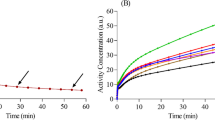Abstract
The purpose of this study is to develop a method of quantitating the cerebral metabolic rate of glucose (CMRglc) by positron emission tomography using a population-based heated venous curve and one-point sampling from a non-heated vein, i.e. that can avoid arterial puncture.Methods: We conducted this study on 17 subjects with a mean age of 61 ± 9 years. A time-concentration curve as an input function was obtained by sampling 24 blood samples, from the heated left hand vein, one before and the others after intravenous injection of 259 MBq of F-18-fluorodeoxyglucose into the right cubital vein. A non-heated venous sample was also obtained from the right cubital vein.Results: The population-based input function was calculated by averaging time-concentration curves from the first 7 subjects. A single sample obtained from 10 other subjects from 7.5 to 20 minutes and 35 and 40 minutes after injection predicted input function well with an error of less than 4.5%. The radioactivity in the non-heated 40 minutes’ sample was 1.7 ± 2.9% higher than in the heated vein. When we calibrated the population-based curve using the non-heated venous samples at 40 minutes in 10 subjects, the calculated CMRglc values were 1.3 ± 5.4% lower than the actual values.Conclusions: Non-heated venous one-point sampling and the population-based curve can decrease the complexity of the procedures and the manpower required, and also make the FDG study less invasive, without a significant increase in measurement error.
Similar content being viewed by others
References
Phelps ME, Huang SC, Hoffman EJ, Selin C, Sokoloff L, Kuhl DE. Tomographic measurement of local cerebral glucose metabolic rate in humans with (F-18)2-fluoro-2-deoxy-D-glucose: validation of method.Ann Neurol 1979; 6: 371–388.
Benson DF, Kuhl DE, Hawkins RA, Phelps ME, Cummings JL, Tsai SY. The fluorodeoxyglucose18F scan in Alzheimer’s disease and multi-infarct dementia.Arch Neurol 1983; 40: 711–714.
Henkel K, Zerr I, Hertel A, Gratz KF, Schröter A, Tschampa HJ, et al. Positron emission tomography with [18F]FDG in the diagnosis of Creutzfeldt-Jakob disease (CJD).J Neurol 2002; 249: 699–705.
Lenzi GL, Frackowiak RSJ, Jones T, Heather JD, Lammertsma AA, Rhodes CG, et al. CMRO2 and CBF by the oxygen-15 inhalation technique. Results in normal volunteers and cerebrovascular patients.Eur Neurol 1981; 20: 285–290.
Patronas NJ, DiChiro G, Smith BH, De La Paz R, Brooks RA, Milam HL, et al. Depressed cerebellar glucose metabolism in supratentorial tumors.Brain Res 1984; 291: 93–101.
Ohtani T, Kurihara H, Ishiuchi S, Saito N, Oriuchi N, Inoue T, et al. Brain tumour imaging with carbon-11 choline: comparison with FDG PET and gadolinium-enhanced MR imaging.Eur J Nucl Med 2001; 28: 1664–1670.
Kuhl D, Engel J, Phelps M, Selin C. Patterns of local cerebral metabolism and perfusion in partial epilepsy by emission computed tomography of18F-fluorodeoxyglucose andl3N-ammonia.Acta Neurol Scand 1979; 60 (Suppl 72):: 538–539.
Sokoloff L, Reivich M, Kennedy C, Des Rosiers MH, Patlak CS, Pettigrew KD, et al. The [14C]deoxyglucose method for the measurement of local cerebral glucose utilization: theory, procedure, and normal values in the conscious and anesthetized albino rat.J Neurochem 1977; 28: 897–916.
Correia J. A bloody future for clinical PET? (editorial).J Nucl Med 1992; 32: 620–622.
Huang SC, Phelps ME, Hoffman EJ, Sideris K, Selin CJ, Kuhl DE. Noninvasive determination of local cerebral metabolic rate of glucose in man.Am J Physiol 1980; 238: E69-E82.
Takikawa S, Dhawan, Spetsieris P, Robeson W, Chaly T, Dahl R, et al. Noninvasive quantitative fluorodeoxyglucose PET studies with an estimated input function derived from a population-based arterial blood curve.Radiology 1993; 188: 131–136.
Wakita K, Imahori Y, Ido T, Fujii R, Horii H, Shimizu M, et al. Simplification for measuring input function of FDG PET: Investigation of 1-point blood sampling method.J Nucl Med 2000; 41: 1484–1490.
Bergström M, Litton J, Eriksson L, Bohm C, Blomqvist G. Determination of object contour from projections for attenuation correction in cranial positron emission tomography.J Comput Assist Tomogr 1982; 6: 365–372.
Van der Weerdt AP, Klein LJ, Visser CA, Visser FC, Lammertsma AA. Use of arterialized venous instead of arterial blood for measurement of myocardial glucose metabolism during euglycaemic-hyperinsulinaemic clamping.Eur J Nucl Med 2002; 29: 663–669.
Reivich M, Alavi A, Wolf A, Greenberg JH, Fowler J, Christman D, et al. Use of 2-deoxy-D[l-11C]glucose for the determination of local cerebral glucose metabolism in humans: variation within and between subjects.J Cereb Blood Flow Met 1982; 2: 307–319.
Bartlett EJ, Brodie JD, Wolf AP, Christman DR, Laska E, Meissner M. Reproducibility of cerebral glucose metabolic measurements in resting human subjects.J Cereb Blood Flow Met 1991; 8: 502–512.
Vingerhoets FJG, Snow BJ, Schulzer M, Morrison S, Ruth TJ, Holden JE, et al. Reproducibility of fluorine-18-6-fluorodopa positron emission tomography in normal human subjects.J Nucl Med 1994; 35: 18–24.
Shinohara Y, Ohnuki Y, Yoshii F, Takahashi W, Onoe K, Takagi S. Detection of primary tumor in paraneoplastic cerebellar degeneration by FDG-PET.Ann Neurol 1998; 43: 684.
Ide M, Suzuki Y. Medical health club with clinical PET.Eur J Nucl Med 1996; 23: 1677–1679.
Author information
Authors and Affiliations
Corresponding author
Rights and permissions
About this article
Cite this article
Takagi, S., Takahashi, W., Shinohara, Y. et al. Quantitative PET cerebral glucose metabolism estimates using a single non-arterialized venous-blood sample. Ann Nucl Med 18, 297–302 (2004). https://doi.org/10.1007/BF02984467
Received:
Accepted:
Issue Date:
DOI: https://doi.org/10.1007/BF02984467




